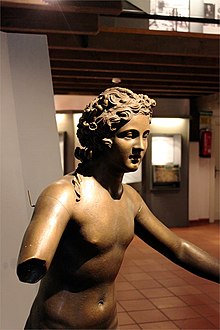Xanten boy
The Xantener Knabe (also Lüttinger Knabe ) is a bronze statue from the Roman Xanten ( Colonia Ulpia Traiana ) in the antique collection in Berlin (inventory number Sk 4). There it stands today in the Bacchus Hall in the Neues Museum .
The boy from Xanten was discovered on February 16, 1858 by six fishermen from Lüttingen and Bislich on the banks of the Rhine near the town of Bislich. The 1.44 m high statue is missing the eyeballs and the right forearm, but otherwise it is largely preserved.
The original function of the figure was that of a mute servant serving food and drink to guests at a feast. The rectangular or oval tray that he was probably holding in his hands has not been found.
The value of the statue was estimated at 8,000 thalers at the time it was found; eight months after it was found, it was brought to the Berlin Collection of Antiquities, where it is still on display today. Casts of the Xanten boy are owned by the Rheinisches Landesmuseum in Bonn , the Deichdorfmuseum in Wesel-Bislich (there also an exhibition area on the history of the finds) and the Roman Museum in Xanten . Another cast of the "Lüttinger Knaben" was made by the Lüttingen Home and Citizens Association and placed in front of the church in Lüttingen. Casts of the figure have been available in the Berlin Gipsformerei since 1860 .
literature
- Hans-Joachim Schalles , Uwe Peltz: The Xanten boy. Technology, iconography, function and dating. (= Xantener reports , Volume 22). Verlag Philipp von Zabern, Mainz 2011, ISBN 978-3-8053-4431-9 ( PDF; 16.51 MB ).
Web links
- Internet catalog of the Berlin sculptures in the archaeological database Arachne .
- The Xanten boy on museumsportal-berlin.de
- The Lüttinger boy on luettingen-info.de
Individual evidence
- ↑ Annette Meier: The 'Xanten Boy' in the Bacchus Hall. Invitation to a party. ( museumsportal-berlin.de , accessed August 27, 2014).

